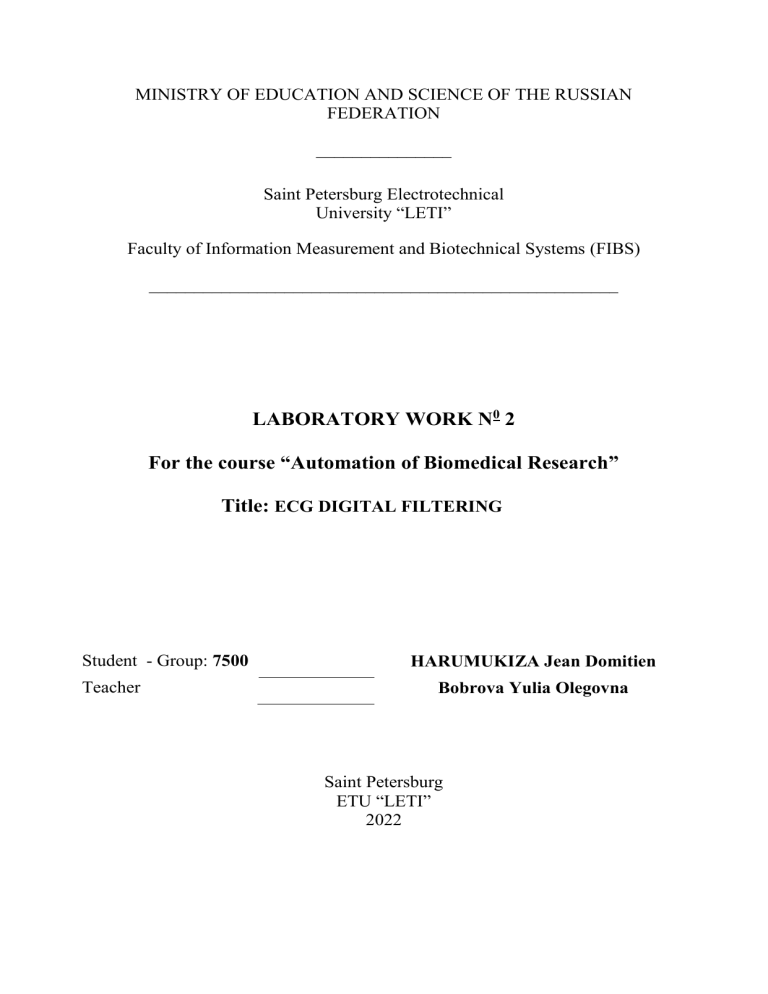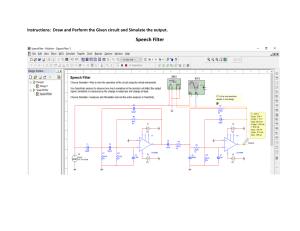ECG Digital Filtering Lab Work: FIR Filters & MATLAB
advertisement

MINISTRY OF EDUCATION AND SCIENCE OF THE RUSSIAN FEDERATION _______________ Saint Petersburg Electrotechnical University “LETI” Faculty of Information Measurement and Biotechnical Systems (FIBS) ____________________________________________________ LABORATORY WORK N0 2 For the course “Automation of Biomedical Research” Title: ECG DIGITAL FILTERING Student - Group: 7500 Teacher HARUMUKIZA Jean Domitien Bobrova Yulia Olegovna Saint Petersburg ETU “LETI” 2022 ECG DIGITAL FILTERING Objective: Practical realization of digital filtering The theory basics Digital filter is a signal processing mathematical algorithm that can be determined by the following difference equation (see formula): 𝑁 𝑦(𝑛) = ∑𝑀−1 𝑖=0 bi x(n − i) + ∑𝑗=1 𝑎𝑗 y(n-j); Where x(n) and y(n) input and output signals samples , 𝑏𝑖 and 𝑎𝑗 the filter coefficients, M and N are the coefficient numbers for the first and second sums. Digital filter is called finite impulse response (FIR) filter, if all aj coefficients are equal to zero, and infinite impulse response (IIR) filter at the opposite case. This work deals only with FIR filters. The variants table (Table W.2) contains two sets of 𝑏𝑖 coefficients that determine two different types of filters (“1” and “2” types). The filter “1” coefficients values are symmetrical relative to the central coefficient of the corresponding filter while the filter “2” coefficients values are anti-symmetrical (i.e. they are symmetrical with the sign minus). The magnitude responses for these two types of filters are determined correspondingly by the following two equations: 𝑀−1 2 H (f) =𝑏𝑀−1 + 2∑𝑘=1 𝑏𝑀−1−𝑘 cos (2𝜋fkT) 2 𝑀−1 2 2 H (f) = 𝑏𝑀−1 + 2∑𝑘=1 𝑏𝑀−1−𝑘 sin (2𝜋fkT) 2 2 Where f: frequency (Hz), and T = 1/Fs: sampling interval for the sampling frequency Fs. Impulse response of a digital filter is the output signal of the filter in case when its input signal represents a single impulse with the magnitude equal to one. Step response of a digital filter is the output signal of the filter in case when its input signal represents sequence of impulses with the magnitudes equal to one, preceded by zeros sequence. The main tasks of the work 1. Calculate and plot the two given filters (“1” and “2” types) for the following main characterise tics: coefficients set, magnitude response, impulse response and step response. 2. The real ECG fragment are read from the file and filtered by the two given filters and the curves of the ECG signals before and after the filtration are plotted. Filters characteristics calculation 1. Start MATLAB and set the filters coefficients for filters 1 and 2, variant 4. 2. Write the difference equation and magnitude response formulas for the filters of “1” and “2”, and creation of coefficients vectors for the two given filters. 𝑏0 = 1/5 𝑏1 = 1/5 𝑏2 = 1/5 𝑏3 =1/5 𝑏4 =1/5 𝑏5 =0 𝑏6 =0 Y1(n) = 0.2x(n) + 0.2x (n-1) + 0.2x (n-2) + 0.2x (n-3) + 0.2x (n-4) H1 (f) = 0.2 + 0.4cos (2𝜋fT) + 0.4cos (4𝜋fT) 𝑏0 = 1/8 𝑏1 = 1/4 𝑏2 = 1/8 𝑏3 = 0 𝑏4 = -1/8 𝑏5 = -1/4 𝑏6 = -1/8 Y2(n) = 0.125x(n) + 0.25x (n-1) + 0.125x (n-2) -0.125x (n-4) -0.25x (n-5) -0.125x (n-6) H2 (n) = 0.25sin (2𝜋fT) + 0.5sin (4𝜋fT) + 0.25sin (6𝜋fT) 4. Create a graphical window that contains eight fields (four rows and two Columns) for plotting: Left column for the plots for the filter “1” and second Column for the filter “2” in order: the filter coefficients; the magnitude Response; the impulse response; the step response. a. Plot in the upper fields the diagrams of “1” and “2” filters coefficients; plot the magnitude response, the sampling frequency Fs = 250 Hz. Calculate and plot the magnitude response, b. Calculate and plot the impulse responses for the filters “1” and “2”: to calculate impulse response, forms the special sequence that contains all values equal to zero except one value that is equal to one. This sequence should be used further as an input for the digital filter (for the difference equation of the filter. Note: The output values can be calculated only for the output array elements Y (M1) and further. c. Calculate and plot the step responses for the filters “1” and “2”. The input sequence should contain zeros from the beginning and ones further. d. Expand the graphical window to all screens. Filtration of the real ECG fragment 5. For filtration of the ECG fragment from the files (variant4) we implement the following operations: read the ECG fragment from the file ( “load” command); create graphical window containing three fields for plots; implement filtration of the ECG fragments using the both given filters; plot in different fields the curves of the input signal and of the output signals after the filters “1” and “2”. Expand the window to all screen for the “Y” scales of the plots are different and set them to the same ranges




